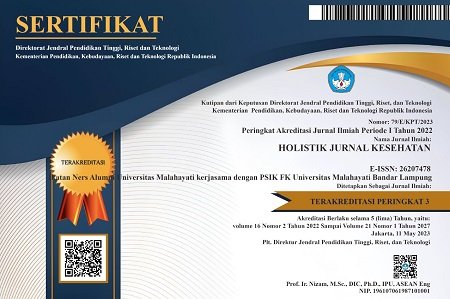PENINGKATAN PENDOKUMENTASIAN CATATAN PERKEMBANGAN PASIEN TERINTEGRASI MELALUI PENGUATAN PERAN KEPALA RUANG DENGAN PENDEKATAN TEORI ORLANDO
Abstract
PUTTING ORLANDO'S THEORY INTO PRACTICE: APPROACH TO INTEGRATED DEVELOPMENT
Background: Documentation of integrated patient development records has not been optimal due to lack of understanding of nurse in writing, and uniformity of the content of writing rules, and there has not yet optimal support from the head nurse.
Purpose: This study is to identify the impact of strengthening the role of the head nurse using the Orlando’s theory approach on the implementation in documented of integrated patient development records.
Methods: Pre experimental design with one group pre test and post test design without control, samples on this study are 115 documents of integrated patient development record, cluster sampling technique, analyzed used with Wilcoxon, Spearman and Kruskal Wallis test analysis.
Results: Showing that the role strengthening of the head nurse with the Orlando’s theory approach significantly improves the quality of implementation for documented of integrated patient development record (p=0.0001; α=0,025). Conclusion: The nursing abilities of the implementers increased significantly in the implementation in documented of integrated patient development record.
Recommendation: As reference to make policies, assistance, evaluation and monitoring of nursing managers and development through workshops on the role of the head nurse and implementation documentation of integrated patient development records.
Keywords: Integrated patient development records, role of the head nurse, Orlando’s theory
Pendahuluan: Dokumentasi catatan perkembangan pasien terintegrasi belum optimal karena kurangnya pemahaman perawat dalam melakukan penulisan, dan keseragaman dari isi kaidah penulisan, serta belum optimalnya dukungan dari kepala ruang.
Tujuan: Mengidentifikasi pengaruh penguatan peran kepala ruang dengan pendekatan Teori Orlando terhadap pelaksanaan pendokumentasian catatan perkembangan pasien terintegrasi.
Metode: Pre eksperiment design dengan one group pre test and post test design without control, dengan sampel 115 dokumen catatan perkembangan pasien terintegrasi, teknik cluster sampling, melalui analisis Wilcoxon, Spearman dan Kruskal Wallis test.
Hasil: Penguatan peran kepala ruang dengan pendekatan Teori Orlando meningkatkan kualitas pelaksanaan pendokumentasian catatan perkembangan pasien terintegrasi secara bermakna (p=0,0001; α=0,025).
Simpulan: Kemampuan perawat pelaksana meningkat bermakna dalam pelaksanaan pendokumentasian catatan perkembangan pasien terintegrasi melalui penguatan peran kepala ruang dengan pendekatan Teori Orlando.
Rekomendasi: Perlunya kebijakan, pendampingan, evaluasi, dan monitoring dari manajer keperawatan serta pengembangan melalui workshop penerapan peran kepala ruang dan pelaksanaan pendokumentasian catatan perkembangan pasien terintegrasi.
Keywords
Full Text:
PDFReferences
Agnew, C., & Flin, R. (2014). Senior charge nurses’ leadership behaviours in relation to hospital ward safety: A mixed method study. International Journal of Nursing Studies, 51(5), 768–780. http://doi.org/10.1016/j.ijnurstu.2013.10.001
Ahmed, M. Z., & Safadi, E. G. (2013). Decisional involvement among nurses: Governmental versus private hospitals. Health Science Journal, 7(1), 18–27.
Alkouri, O. A., Just, T., & Kawafhah, M. (2016). Importance And Implementation Of Nursing Documentation: Review Study. European Scientific Journal, 12(3), 101–106. http://doi.org/10.19044/esj.2016.v12n3p101
Almost, J., Doran, D. M., Mcgillis Hall, L., & Spence Laschinger, H. K. (2010). Antecedents and consequences of intra-group conflict among nurses. Journal of Nursing Management, 18(8), 981–992. http://doi.org/10.1111/j.1365-2834.2010.01154.x
Blair, W., & Barbara Smith. (2012). Nursing Documentation: Framewor and barriers. Cotemporary Nurse, 41(2), 160–168.
Cartwright-vanzant, R. C. (2010). Medical record documentation : Legal aspects in neonatal nursing. Newborn and Infant Nursing Reviews, 10(3), 134–137. http://doi.org/10.1053/j.nainr.2010.06.008
Chelagat, D., Sum, T., Chebor, A., Kipto, R., & Bundtich, P. (2013). Documentation : Historical perspectives , purposes , benefits and challenges as faced by nurses. International Journal of Humanities and Social Science, 3(16), 236–240. Retrieved from http://www.ijhssnet.com/journals/Vol_3_No_16_Special_Issue_August_2013/28.pdf
Chapman, A. L. N., Johnson, D., & Kilner, K. (2014). Leadership styles used by senior medical leaders leadership development, 27(4), 283–298. http://doi.org/10.1108/LHS-03-2014-0022
Darawad, M. W., & Al-Hussami, M. (2013). Jordanian nursing students’ knowledge of, attitudes towards, and compliance with infection control precautions. Nurse Education Today, 33(6), 580–583. http://doi.org/10.1016/j.nedt.2012.06.009
Gatling, A., Shum, C., Book, L., & Bai, B. (2017). International Journal of Hospitality Management The influence of hospitality leaders ’ relational transparency on followers ’ trust and deviance behaviors : Mediating role of behavioral integrity. International Journal of Hospitality Management, 62, 11–20. http://doi.org/10.1016/j.ijhm.2016.11.010
Griffiths, P., Anderson, A., Coyne, C., Beastall, H., & Hill, J. (2011). Implementing an interprofessional patient record. Clinical Medicine, Journal of the Royal College of Physicians of London, 11(2), 128–131. http://doi.org/10.7861/clinmedicine.11-2-128
Hariyati, S. T. R., Yani, A., Eryando, T., Hasibuan, Z., & Milanti, A. (2015). The Effectiveness and Efficiency of Nursing Care Documentation Using the SIMPRO Model. International Journal of Nursing Knowledge, (January 2016). http://doi.org/10.1111/2047-3095.12086
Ioanna, P., Stiliani, K., & Vasiliki, B. (2007). Nursing documentation and recording systems of nursing care. Healt Science Journal, (4).
Jakson Dwyer, & Diana. (2014). Interpersonal relationships. New York: Routledge.http://doi.org/10.4324/9780203797853
John, S. K., & Bhattacharya, P. C. (2016). Documentation guidelines based on expectation of documentation helps accurate documentation among nurses in psychiatric settings. Asian J. Nursing Edu and Research, 6(June), 260–265. http://doi.org/10.5958/2349-2996.2016.00050.1
Kumah, E., Ankomah, S. E., & Antwi, F. (2016). The Role of First-Line Managers in Healthcare Change Management : A Ghanaian Context Abstract : International Journal of BioSciences, Healthcare Technology and Management, 6(3), 20–33.
Kumar, P. (2015). An Analytical study on Mintzberg ’ s Framework : Managerial Roles, 2(3).
Laurent, C. L. (2000). A nursing theory for nursing leadership. Journal of Nursing Management, 8(2), 83–87. http://doi.org/10.1046/j.1365-2834.2000.00161.x
Lockwood, W. (2017). Documentation : Accurate and Legal.
Miri, S. A., Mansor, N. N. A., Alkali, A., & Chikaji, A. (2014). The role of first line nurse manager. Review of European Studies, 6(4), 31–41. http://doi.org/10.5539/res.v6n4p31
Nakate, G. M., Dahl, D., Petrucka, P., Drake, K. B., & Dunlap, R. (2015). The Nursing Documentation Dilemma in Uganda: Neglected but Necessary. A Case Study at Mulago National Referral Hospital. Open Journal of Nursing, 5(December), 1063–1071. http://doi.org/10.4236/ojn.2015.512113
Potter, P.A., & Perry, G.A. (2010). Fundamental of nursing (7th ed.). St. Louis: Mosbay Elsevier.
Robbins, P.S & Judge, A. . (2013). Organizational Behavior (15th ed.). Boston: Pearson.
Sheldon, L. K., & Ellington, L. (2008). Application of a model of social information processing to nursing theory: How nurses respond to patients. Compilation Journal of Advanced Nursing, 64(4), 388–398. http://doi.org/10.1111/j.1365-2648.2008.04795.x
Skytt, B., Ljunggren, B., Sjoden, P. O., & Carlsson, M. (2008). The roles of the first-line nurse manager: Perceptions from four perspectives. Journal of Nursing Management, 16(8), 1012–1020. http://doi.org/10.1111/j.1365-2834.2006.00684.x
Suwandej, N. (2015). Factors Influencing Total Quality Management. Procedia - Social and Behavioral Sciences, 197(February), 2215–2222. http://doi.org/10.1016/j.sbspro.2015.07.361
Tappen, R. M. (2011). Advance nursing research : From theory to practice. USA: Joces & Bartlett Learning.
Taylor, H. (2003). An exploration of the factors that affect nurses’ record keeping. British Journal of Nursing, 12(12), 751-754-758.
Union in Health. (2012). Record Keeping Guidlines, (October).
Valentine, S. O. (2005). Nursing leadership and the new nurse. Journal of Undergraduate Nursing Scholarship, 4(1), 1. Retrieved May 18, 2005, from http://juns.nursing.arizona.edu/articles/Fall%202002/ Valentine.htm
Witges, K. A., & Scanlan, J. M. (2014). Understanding the role of the nurse manager: The full-range leadership theory perspective. Nurse Leader, 12(6), 67–70. http://doi.org/10.1016/j.mnl.2014.02.007
DOI: https://doi.org/10.33024/hjk.v13i1.858
Refbacks
- There are currently no refbacks.
Copyright (c) 2017

This work is licensed under a Creative Commons Attribution-NonCommercial 4.0 International License.














